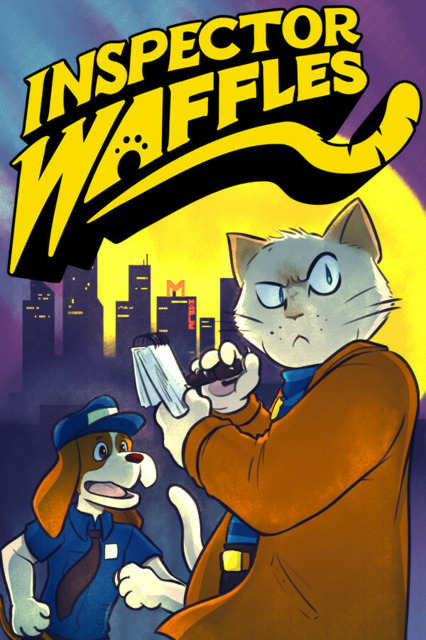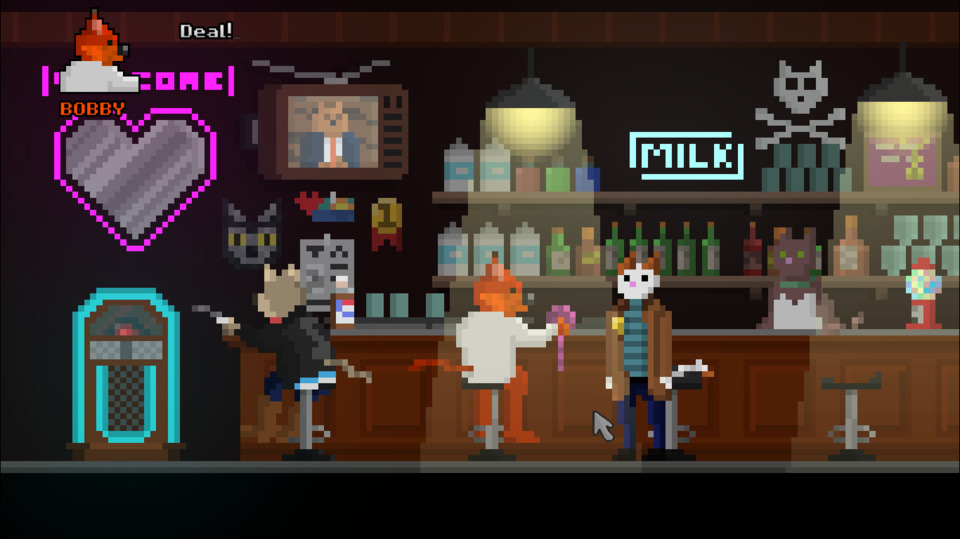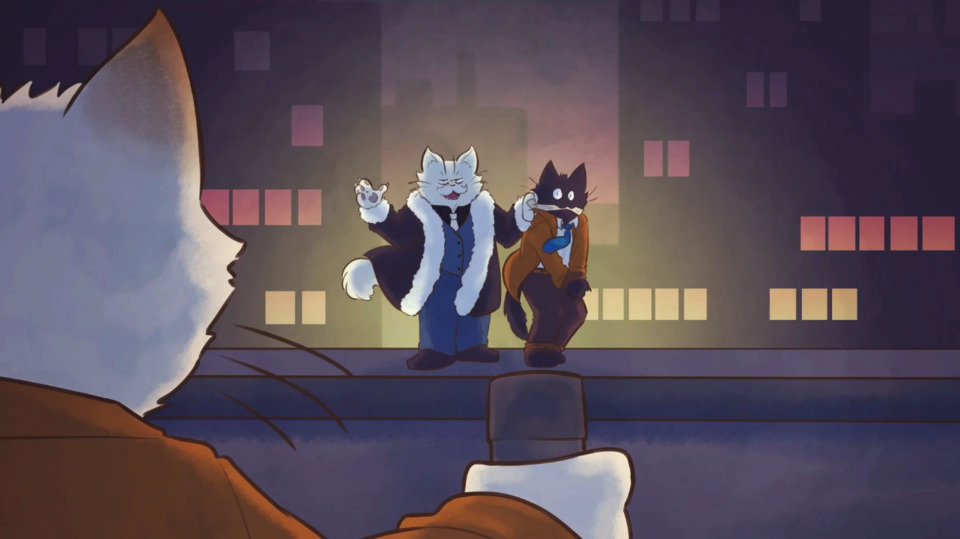Indie Game of the Week 285: Inspector Waffles
By Mento 0 Comments

It's dawning on me that, for as expansive as my love of adventure games has become in the past decade, one of my favorite archetypes remains the detective format for the way the clue-finding and interrogation aspects of the job integrate so well into the pre-existing point-and-click template. Deductions require physical evidence and information to make, after all, and this genre can afford to pace itself to reveal as much or as little to the player as it deems necessary for the level of intrigue it wants to maintain. When I think about games like Ace Attorney or Danganronpa or Kathy Rain, where you repurpose everything you've found and learned as incontrovertible proof of guilt (or innocence) it's a satisfying way to reward the diligence, perception, and critical thinking skills this genre thrives on. Even if Inspector Waffles is a comical world of sapient cats and dogs that likes dropping animal puns like there's no tomorrow, it still understands the appeal of a crime procedural as you move ever closer to the culprit through your own wits and persistence.
Inspector Waffles has its titular tabby detective investigate the murder of Fluffy, the wealthy CEO of a cardboard box manufacturing company (the only toys cats care about), and discover a thread that leads all the way back to his imprisoned Moriarty of a nemesis, Snowball. Those are the broad strokes of the story, but in describing it in such simple terms precludes the number of diversions and leads that has him interrogating a series of sketchy and amusing characters, poking around crime scenes, and working with his colleagues at the police station like the overly eager sniffer patroldog Spotty and the portly, Wiggum-like Chief Patches.

The game's comedy is delivered in a deadpan fashion, where the copious amounts of goofs and references tend to wash over an otherwise played straight noirish story of revenge, regret, and murder. Overall the writing's fairly decent, between establishing the personalities of its large cast of characters and Waffles' own internal monologues, and like other games in this thematic genre the conversation system is one powered by gathering evidence beforehand: if you have the right clue or piece of evidence in your inventory, you can press the right person for the information you need to proceed with the case. Otherwise, that interrogation prompt remains in that character's dialogue menu until you have what you need to resolve it, making it obvious enough what you should be focusing on figuring out next. The world of Inspector Waffles starts relatively small, with locations entering and exiting the fast-travel menu when applicable, so it has that serendipitous quality common to compact Indie adventure games where a smaller number of options means less "stabbing in the dark" at progress flags is required.
Despite having some stylized art for its comic book-style cutscenes and title screen, most of the game uses a very lo-fi pixel look that affords the developers the chance to create detailed scenes, but the low pixel count also means that it's hard to make out what a lot of the things in those scenes actually are; generally speaking, if you can mouse over it to get its name, it's potentially important (and thus anything that doesn't have pop-up text can be considered dressing) but when the game decides to be cute and squeeze in references to other games in the background, like the nerdy knick-knacks on the shelf of police IT expert Pixel's office, it's almost impossible to tell what is being referenced. Art isn't everyone's strong point, and it's perhaps less vital in a narrative-heavy medium where the writing and puzzles take priority, but I don't think this abstract style does a details-oriented game like this many favors.

To give the game a little more content there's a collectible card system where following trails of clues can sometimes result in a new rare card for the player's album: as this album was taken from one of the main suspects, it's hinted that filling it up before handing it back to its previous owner will unlock some additional narrative. Otherwise, it mostly exists as a way to sprinkle around some red herring threads that, instead of leading to the next story beat, simply lead to one of these tchotchkes: it's far from being unwelcome though, as it means you have multiple leads to occupy you if you're stuck on any one for the time being. The uncommon inclusion of a side-quest in an adventure game does give Inspector Waffles a bit more distinction, at the very least.
Inspector Waffles has some flaws but I think the meat of its noir tale is solid and hits the notes it means to. The particular way its puzzles are presented mitigates much of the frustration with this older genre, as you always at least have some idea what piece of information or evidence you need to progress if not where it might be found, and the way locations disappear when they're no longer needed or Waffles mentally conceives of a reason to not talk to someone when they no longer have relevance to the story means escaping that "hotspot redundancy" that can grind adventure games to a halt, where you keep interacting with items and people that no longer serve a purpose. The story, which uses the same balance of serious, dramatic moments in its core narrative and lots of silly levity in the periphery, reminds me of how the Yakuza games handles its storytelling too, which is obviously a positive as well. I think I'm close to the end after about four hours, so it's about the right size for a game of its type too; I could certainly see some further moderately-sized adventures in the pulpy universe of animal-people it's created. On the whole, it's for sure recommended if you like the type of adventure game that has you piece together cases one conspicuous pixel at a time. And also have a healthy tolerance for pet puns, because it'll drive you barking mad if you don't.
Rating: 4 out of 5.
Post-Playthrough Edit: Not much to add except to say the game got extremely wholesome towards the end in a way I wasn't expecting. It almost made me forget that multiple animal-people had already died up to that point.
| < Back to 284: Siactro Showcase | The First 100 | The Second 100 | > Forward to 286: The Pedestrian |
